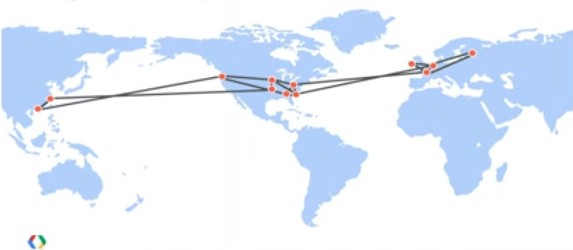This article is more than 1 year old
Google takes on AWS, Azure virty servers with micro billing and fat disks
Compute Engine open for all
Google I/O Google is done dabbling with raw compute and storage infrastructure and has thrown the doors wide open on its Compute Engine services, while at the same time offering finer-grained pricing and fatter persistent storage for its virtual machines than is available from Amazon Web Services, Microsoft Windows Azure, and other public clouds.
In a session following the keynote today in San Francisco, Urs Hölzle, senior vice president for technical infrastructure, discussed Google's Cloud Platform, revealing enhancements to Compute Engine, a service launched in June 2012, which competes with Amazon EC2, Microsoft Azure Compute, Rackspace Cloud, and a slew of others.
"Many of you want and need access to raw VMs, and that's important," he said. "We rolled out Compute Engine a year ago, and we have rolled out a ton of improvements since then."
The biggest and most important change is a sensible, even radical, shift in pricing as Compute Engine becomes generally available. Instead of charging per-hour for compute capacity for raw virty server slices, as everyone in the industry does, Google is to charge by the minute.
"Today, the standard unit of measure for compute is an hour, regardless of how much time you actually use," said Hölzle. "So if you have a 15 minute job that is done after 15 minutes, you still pay for 60 minutes, which increases your actual costs by four times."
"So just think about that. Imagine making a 15 minute phone call and then you get charged for a full hour. It makes no sense. And starting today, you won't get overcharged like that on Compute Engine."
Google has a caveat and qualifier on those per-minute charges for Compute Engine instance capacity. The charges are indeed billed in one-minute increments, but you have to pay with a ten-minute minimum.
Even so, in one fell swoop, Google has wiped out a whole chunk of profits that all of the other cloud providers have been counting on - like Bitcoins. Maybe a little too much like Bitcoins. . . .
Google's price list for Compute Engine instances still shows per-hour fees for virty machines hosted in Google's US and European data centers. Presumably, the per-minute rate for any machine is the hourly rate divided by 60 with a 10-minute minimum.
The current price list is effective as of December 1, 2012 and El Reg confirmed with Google that the billing system for Computer Engine will figure out the minutes. And by the way, it rounds up to the next minute if you go a second beyond a minute.
Another change as Compute Engine moves into general availability are shared-core instances. These are small, sub-core instances, like those available on other clouds, but unlike the tiny VMs on other clouds, according to Hölzle, who says the two from Google have predictable and consistent performance, not best-effort performance.
The g1-small instance has one virtual core, 1.7GB of virtual memory, and no persistent disk; it costs 5.4 cents per hour. The f1-micro instance has a single virtual core, 600MB of virtual memory, and no persistent disk and costs 1.9 cents per hour.
According to Hölzle, these instances are ideal for experimentation and are aimed at tasks that don't need a lot of resources but which you want to have running for a long time at a reasonable cost.
Big storage
The other big change that will cause heartburn at other public cloud providers is Google's decision to offer 10TB of persistent storage as an option for Compute Engine instances.
"Our persistent disks are limited to 1TB, and even though it matches what other providers have, it wasn't really enough," Hölzle says. "And you asked us to make them bigger and you were right – 1TB isn't really big enough."
This may not be as big as a deal as when Google offered 1GB of email storage when Gmail launched so many years ago at a time when others offered tens of megabytes. But the combination of minute billing and fat persistent disks is going to have a ripple effect on pricing throughout the cloud.
Just like every time Amazon Web Services cuts prices it does. Google buys enough iron that it can probably get into a price war with Amazon, and it sure as hell has a lot more profits than the e-tailing giant ever dreamed of.
This cloud price war is going to be fun to watch, especially if you are a customer.
Routing and OpenFlowing
Hölzle did not make a big fuss about the networking that underpins the Compute Engine service, but he noted an Advanced Routing feature that creates a virtual private network to link from your on-premise infrastructure over a secure tunnel.

Google is a pioneer in using OpenFlow SDN in production
He also bragged that with everyone yammering about OpenFlow and software-defined networks, Google has operated an OpenFlow backbone with several terabits per second of aggregate bandwidth that connects its data centers in North America, Europe, and Asia for the past two years.
Of course, Google is also rich enough to lay its own undersea fiber optic cables to link its data centers, too. Few companies on the planet can afford to do that. ®
